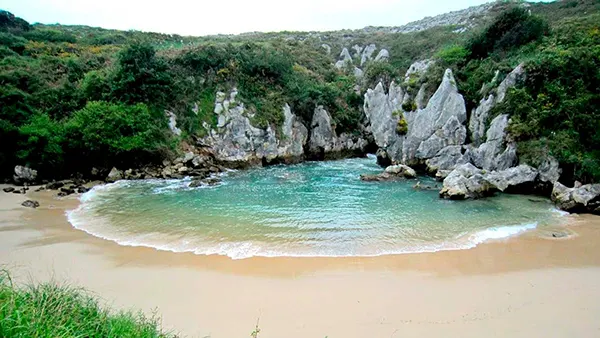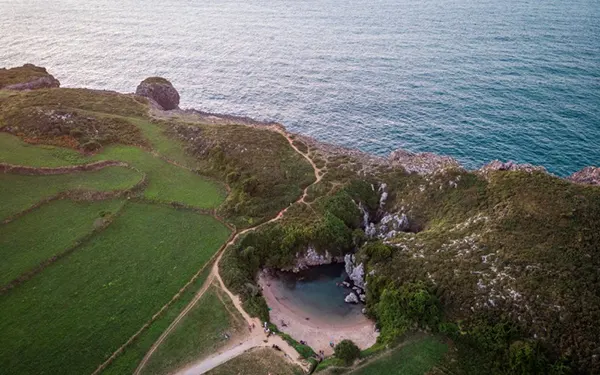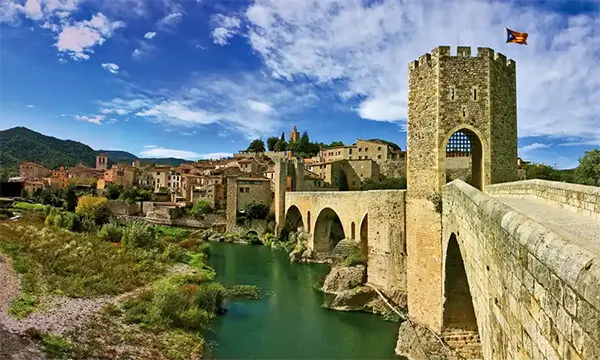Playa de Gulpíyuri: A Hidden Inland Beach in Asturias

Playa de Gulpíyuri is one of Spain’s most unusual natural landmarks: a small inland beach formed by a collapsed limestone cave system. Located near Naves in Asturias, it sits unexpectedly between green meadows rather than next to the open sea, yet it is connected to the Cantabrian coast through a network of saltwater tunnels. This rare geological formation attracts visitors who appreciate authentic landscapes shaped by natural processes rather than typical seaside scenery.
The Geological Origin of Playa de Gulpíyuri
The beach exists due to coastal erosion acting on the limestone cliffs of northern Spain. Over thousands of years, waves carved underwater channels and hollowed out a large cave whose roof eventually collapsed. As a result, seawater now enters the hollow through natural tunnels, filling the sandy depression and creating a beach surrounded entirely by grasslands.
This formation is classified as a sinkhole beach, a type found in only a few locations worldwide. According to regional environmental studies conducted up to 2025, the hydrodynamic system of Gulpíyuri remains stable, with tidal activity continuing to supply seawater through the subsurface passages. During high tide the water rises considerably, while in low tide the beach may remain shallow or nearly dry.
Despite its small size—approximately 50 metres in length—the beach is considered a unique example of karst coastal geomorphology. Scientists from the University of Oviedo have highlighted it as a key site for understanding how subterranean seawater circulation shapes the Asturian coastline.
The Role of Tides and Seasonal Changes
Tidal influence is crucial to the beach’s daily appearance. The water arrives through narrow rock channels that react differently depending on tide levels, wind direction, and seasonal wave strength. In winter the inflow is stronger due to heavier swell in the Bay of Biscay, while during summer months the water movement is calmer.
Visitors arriving without considering tidal hours might find the beach partially drained. The regional coastal authority recommends checking updated tidal charts when planning a visit. These recommendations for 2025 remain consistent with previous years, as the subsurface channels continue to function naturally without artificial reinforcement.
Seasonal conditions also affect the beach’s surroundings. Heavy rainfall in early spring can lead to temporary pooling near the meadows, although this does not interfere with seawater inflow. Environmental monitoring confirms that the site maintains stable ecological conditions throughout the year.
Accessibility and Visitor Experience
Playa de Gulpíyuri is accessible only on foot. The nearest parking area is roughly a kilometre away, after which a narrow rural path leads across meadows toward the sinkhole. This setting enhances the location’s natural authenticity: no commercial establishments or paved infrastructure exist near the beach, in accordance with local conservation policies.
The beach was declared a Natural Monument by the Principality of Asturias, ensuring strict protection rules. These regulations aim to minimise erosion and prevent overcrowding, a growing concern as inland beaches have gained international interest. By 2025 regional authorities encourage sustainable visits, including limiting group sizes and respecting marked footpaths.
Although the beach is small and often visited briefly, many travellers appreciate its simplicity and unusual landscape. The surrounding meadows provide open views of the coastal cliffs, and the sound of waves travelling through underground tunnels creates a distinctive acoustic effect that differs from ordinary shorelines.
Practical Tips for Visiting
Due to the beach’s limited space, early morning or late afternoon visits are more comfortable. Midday hours during peak season often lead to crowding, which can diminish the experience for those seeking a calmer environment. Local recommendations stress maintaining distance from the sinkhole’s edges to avoid compacting the soil.
Footwear suitable for uneven paths is advisable, particularly after rain when the trail can become soft. As the area lacks shops or cafés, visitors should bring water and sun protection. The nearest services are located in the nearby villages of Naves and Llanes, both offering rural accommodations and traditional Asturian cuisine.
Photography enthusiasts often visit during high tide, when the water reaches its highest point inside the sinkhole. However, even at low tide the site offers excellent visual contrast between the sand, green fields, and karst formations. Drone use is regulated and subject to regional permissions to protect wildlife and avoid disturbance.

Environmental Significance and Conservation
Playa de Gulpíyuri forms part of a broader protected coastline that includes limestone cliffs, sea caves, and dune habitats. These ecosystems host a variety of plant species adapted to saline environments despite the inland position of the beach. The conservation status aims to preserve both the geological structure and the surrounding flora.
Monitoring programmes conducted through 2020–2025 indicate that visitor pressure remains the primary environmental challenge. Soil compaction, trampling of vegetation, and erosion of informal paths have been recorded. In response, authorities have expanded educational signage and reinforced designated routes to reduce ecological impact.
The beach also plays a role in regional research focusing on climate change and coastal dynamics. As sea levels continue to shift, scientists are studying how increased storm activity may affect the underground channels that feed Gulpíyuri. These observations contribute to a better understanding of northern Spain’s sensitive karst coastline.
Future Outlook and Preservation Efforts
Local government initiatives for 2025 emphasise safeguarding the site through controlled visitor access and regular ecological assessments. While no restrictions on entry are planned, management strategies aim to balance tourism interest with long-term preservation.
Collaboration between regional authorities, universities, and environmental groups supports ongoing research. Their analyses provide valuable data used to predict potential impacts on the subsurface hydrology that maintains the beach’s unique characteristics.
Maintaining Gulpíyuri’s natural integrity requires continuous public awareness. Educational campaigns encourage respectful behaviour, helping ensure that future generations can appreciate one of Spain’s rarest geological formations without compromising its ecological stability.



